How Google Maps Makes Money: With Visuals & Revenue Estimate
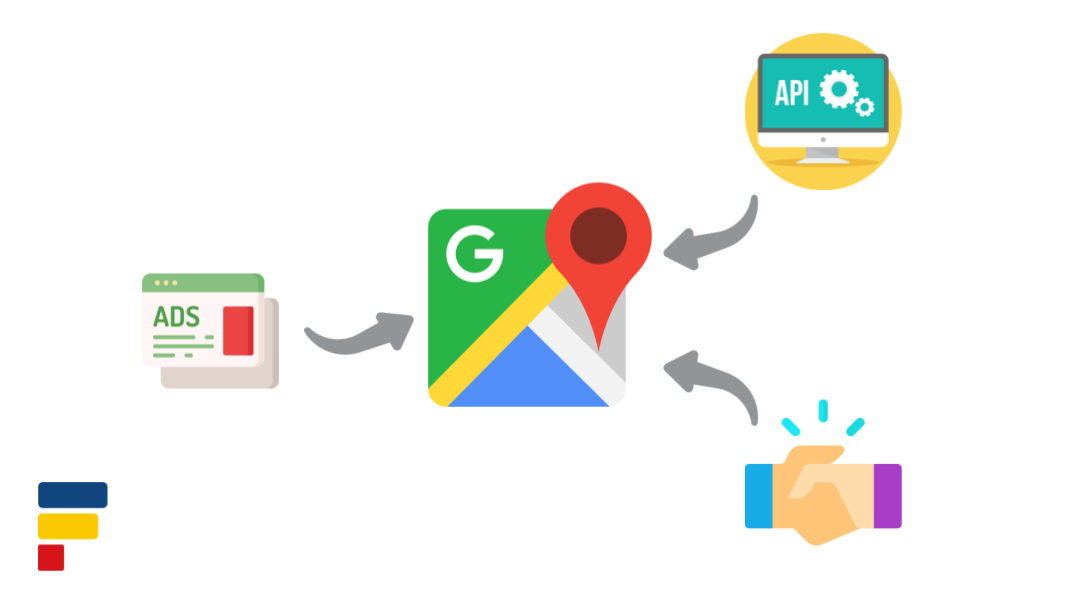
Google Maps has dominated the online mapping business for more than a decade. Service was launched in February 2005 and quickly became the most prominent mapping service. Everybody somehow got used to the fact that it is excellent, detailed, free, and mostly without adds. Well, Google decided that it’s time to change that and start making serious money from Google Maps. How is Google exactly making money from Google Maps, and how much?
Google Maps makes money through two primary revenue sources:
- Local Ads: Ads at the top of local business listings and custom branded map pins ($3.5bn a year).
- Google Maps API & Partnerships: Google offers Maps API for a fee for other app developers and businesses (e.g., Uber & Lyft) ($0.8bn per year)
Google does not disclose details about Google Maps revenue, and the numbers I showed you above are only estimates. In the rest of the article, I will give you a more detail insight into where is this revenue coming from, how I estimated it and why it will probably continue to grow strongly in the coming years.
🗺️ What Google Maps Service Offers: Quick Overview
Before we get into how Google Maps makes money, let me just quickly remind you of the scale of functionalities that Google Maps currently offer to its users and businesses because Google added a lot of new stuff lately.
What you can use Google Maps for?
- Search local places and business listings (restaurants, shops, dentists, car repair shops, etc.). Google Maps listings also show up in standard Google Search results for local searches.
- Use it as a normal map and explore it in a standard or satellite view.
- 360° panoramic Street View (you can sometimes go even inside buildings)
- Use route planning and navigation to get where you need with community-driven data on crashes, speed traps, and traffic slowdowns.
- One of the newer features is Live View navigation using augmented reality
- Businesses can add their locations to Google Maps through the “Google My Business” service.
What you can use Google Maps API for?
- Create your custom maps, adjust it to your needs, and embed it on your web page ar application.
- Visualize data as an overlay on top of Google Maps
- Use Google Maps in a backend of your application or service like ridesharing, gaming, or asset tracking. For example, Uber’s app uses the Google Maps API.
💵 How Much Money Google Maps Makes and Why It Will Increase
Google does not disclose detail about how much money Google Maps makes. One of the few numbers that Google discloses is the number of users active each month, which is 1 billion. That puts Google Maps far ahead of its competitors both worldwide and also in the United States. Google Maps had 154 million in the US, which is a 6-time more than its closest competitor.
So how much is Google Maps’ revenue? Here is an infographic explaining how Google Maps earns approximately $4.3 bn revenue a year based on my rough estimates for next year. It consists of $3.5bn of revenue from advertising and $0.8bn in revenue from Google Maps API.
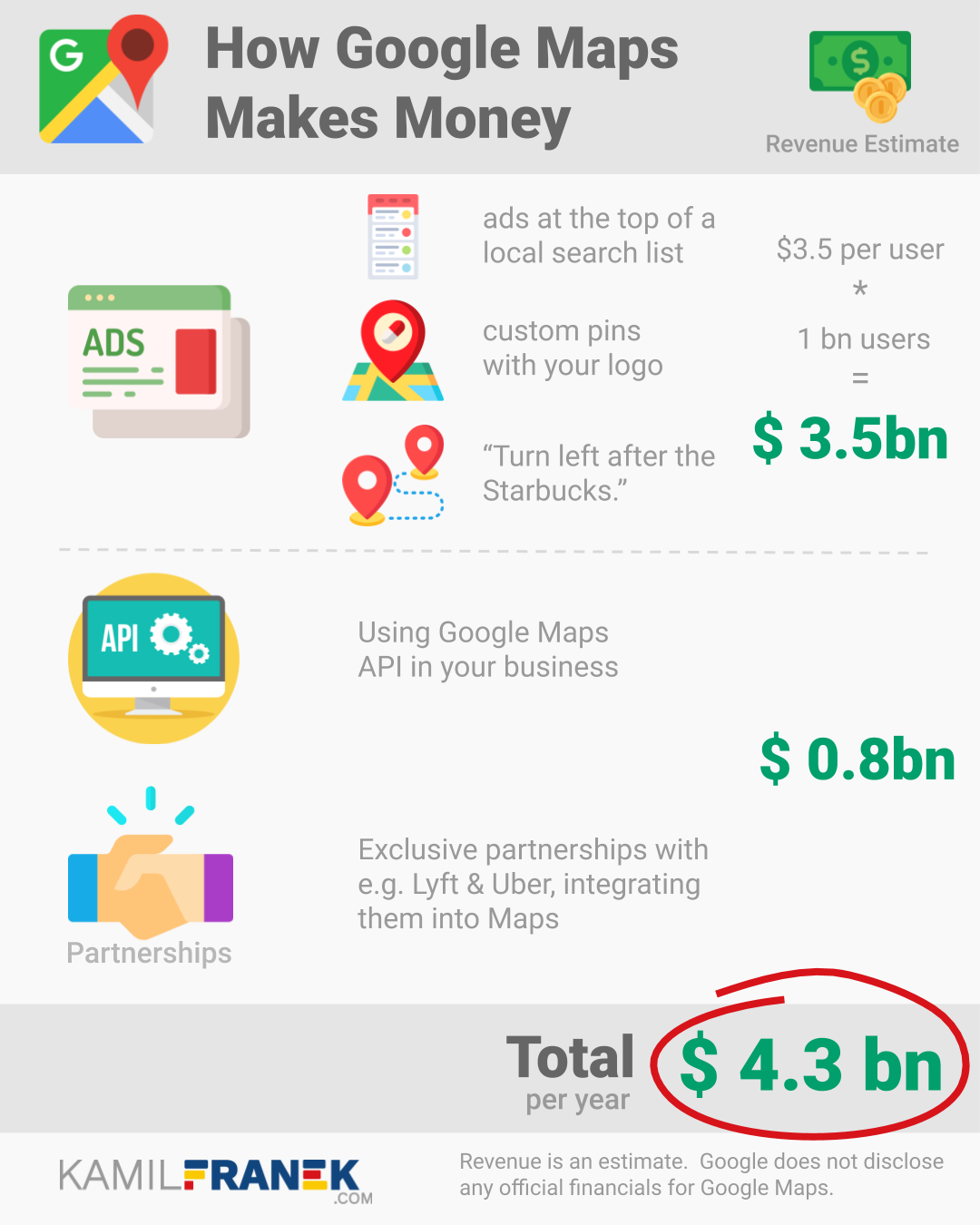
If you are interested in how I exactly arrived at these numbers, I will explain it later in this article. I also looked around for estimates of some other analyst, and the one being repeated over and over in many articles was an estimate of Brian Nowack from Morgan Stanley is slighter higher assuming 3bn revenue in 2019, 5bn a year in 2020 and growth to 11bn in 2023.
For a long time, Google did not monetize its Maps through adds, and also its Google API access was cheaper and mostly free for a smaller site. It changed recently.
Google is starting pushing more adds in Google Maps to drive revenue. However, they are doing it slowly to see how will the users react. Service is still heavily under-monetized.
“We’ve been pretty careful about not being very aggressive about how we present those [ads] to users because we don’t want users to feel like we’re overloading the experience”
–Rajas Moonka, director of product management for Google Maps as reported by Bloomberg
They also merged their separate mapping API into one “Google Map Platform” and significantly increased its pricing and limited free access to the API.
Google also publicly announced this push, so their actions are in line with what Google is saying. That means that Google Maps revenue can increase significantly, just in a few years. And since the costs of this service already exist, any revenue increase will mean an incremental increase in net income before tax.
That is why it is such a significant opportunity for Google/Alphabet and why revenue from Google Maps can double in a few years. That would mean revenue of $8 billion or even more a year, according to my estimates.
🔎 How Google Maps Makes Money From Ads
Let’s look at different ways Google can earn money through adds in Google Maps (3.5bn estimate in 2019). How it exactly works?
Local Search Ads within Google Maps
Google Maps allows you to do a local search. You can zoom in on a city or specific city area and search for restaurants, hotels, dentists, shops, or any other businesses. A list of these businesses will show up, and you can scroll through them.
Advertising works the same way as in standard Google Search. The paid listing will show at the top, distinctly tagged as “Ad.” The paid listing also has a different color (purple) of the pin directly on the map. You can see all of that in the example below.
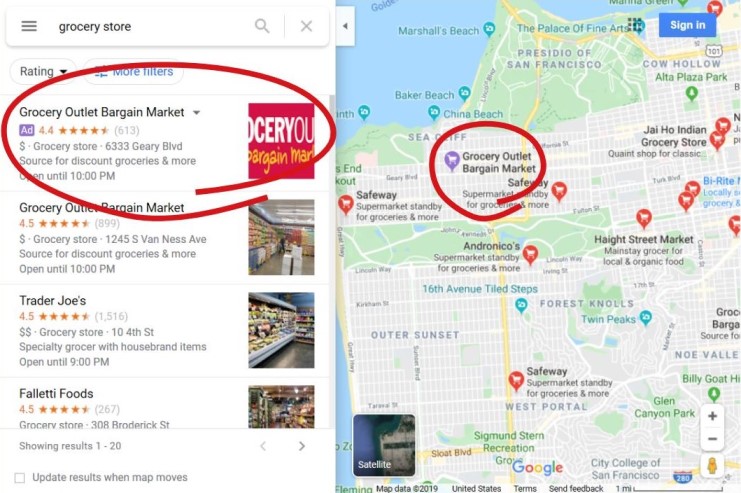
For advertisers, there is not some unique way how to advertise only in Google Maps. Service is part of local search advertising. To be able to advertise in Google Maps search, the business has to have its “Google My Business Profile” and enable “location extensions” in Google Ads. Advertisers will pay only if their ad gets clicked on, similar to standard Google Ads.
Custom Branded Map Pins
Another way how Google is monetizing Google Maps through add revenue by offering businesses custom branded pins that will feature a business logo. These pins show up right on the map, even if you are not looking for a specific business. You can see an example with Walgreen in San Francisco.
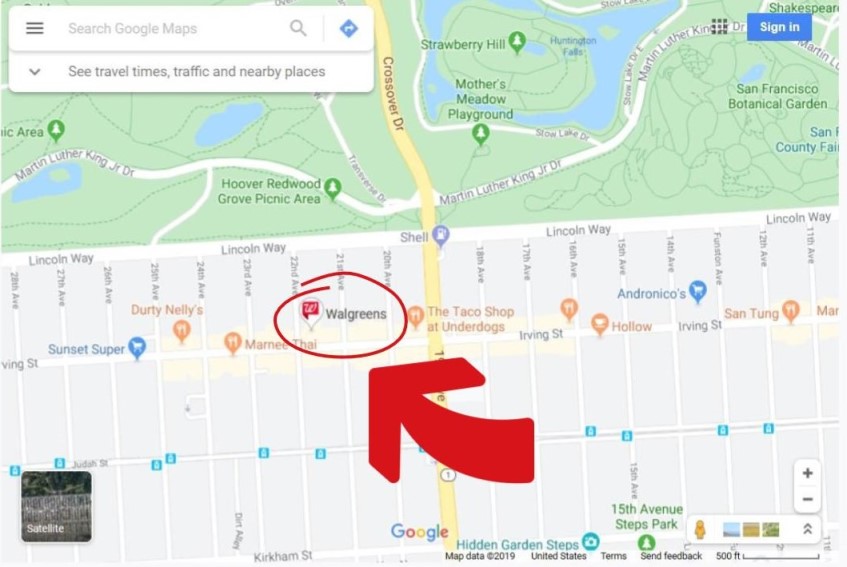
This feature is, of course, a paid feature, and you have to meet some minimum spend a minimum number of locations to use it.
Using retail locations as a landmark in navigation
Many users reported (see example of tweets belows) that when they were using Google Maps for navigation, they noticed that Google started to use local business locations as navigation points. So people were given directions like “Turn right at the Starbucks” or “Turn right after Burger King”. Some of the users like that some of them not so much.
Google Maps just told me to “turn right after the Burger King.” Is that new? New advertising income stream?
— Stephen Fleming (@StephenFleming) February 22, 2018
So @googlemaps instructed me to “turn right after Burger King” ... I think this is the best update yet. #mindblown
— Dee(mah) (@iamdeemah) April 14, 2018
Wonder how much #McDough paid @googlemaps to tell me to turn right at the @McDonalds... yall aint slick... i dont need "advertised landmarks", left and right is just fine...
— Morgan Fykes (@Shmorgan85) February 9, 2018
Google, as was reported by Bloomberg, denies that this is a paid service, and they said that they use it because it is a better landmark, and it results in better user experience.
Well, it might be true that Google’s customers do not pay for it directly, but since so far, it was mostly bigger companies which were mentioned as a landmark, this looks more like some perk for bigger Google ads buyers. I guess it should be possible to evaluate it after a few years and do some analysis if there is some obvious bias in a way these landmarks are chosen.
💵 How Much Money Google Maps Makes From Ads with Revenue Estimate Details.
Google does not disclose the revenue of Google Maps service. 3.5bn advertising revenue I mentioned earlier in the article is based on my rough estimates. And since I think estimates and predictions without more details about why and how they were put together are useless, let me explain to you how I arrived at those estimates.
Step #1: Gather Reliable Data about Google Maps
The only number but quite helpful that we have directly from Google is that Google Maps has 1 billion active users. So if we can somehow find out how much revenue Maps earn per one user, we can multiply it by 1bn, and we will have an annual revenue estimate for Google. Unfortunately, Goggle doesn’t disclose it.
Step #2: Gather Reliable Data about Similar Businesses (Benchmarks)
So how to find out annual revenue per user for Google Maps when Google is quite secretive about it? One approach might be to look around at some similar add-driven services for which we know revenue per user and use it as a benchmark of possible values. We will never get to the exact answer, but the benchmark can limit the subjectiveness of our estimates and get us some reasonable range.
Fortunately for us, a business model with free service and its monetization through advertising is quite popular currently. Here is a chart where I handpicked several companies that disclose the number of monthly active users, and their revenue is coming primarily from ads. (numbers were for averages in 2018)
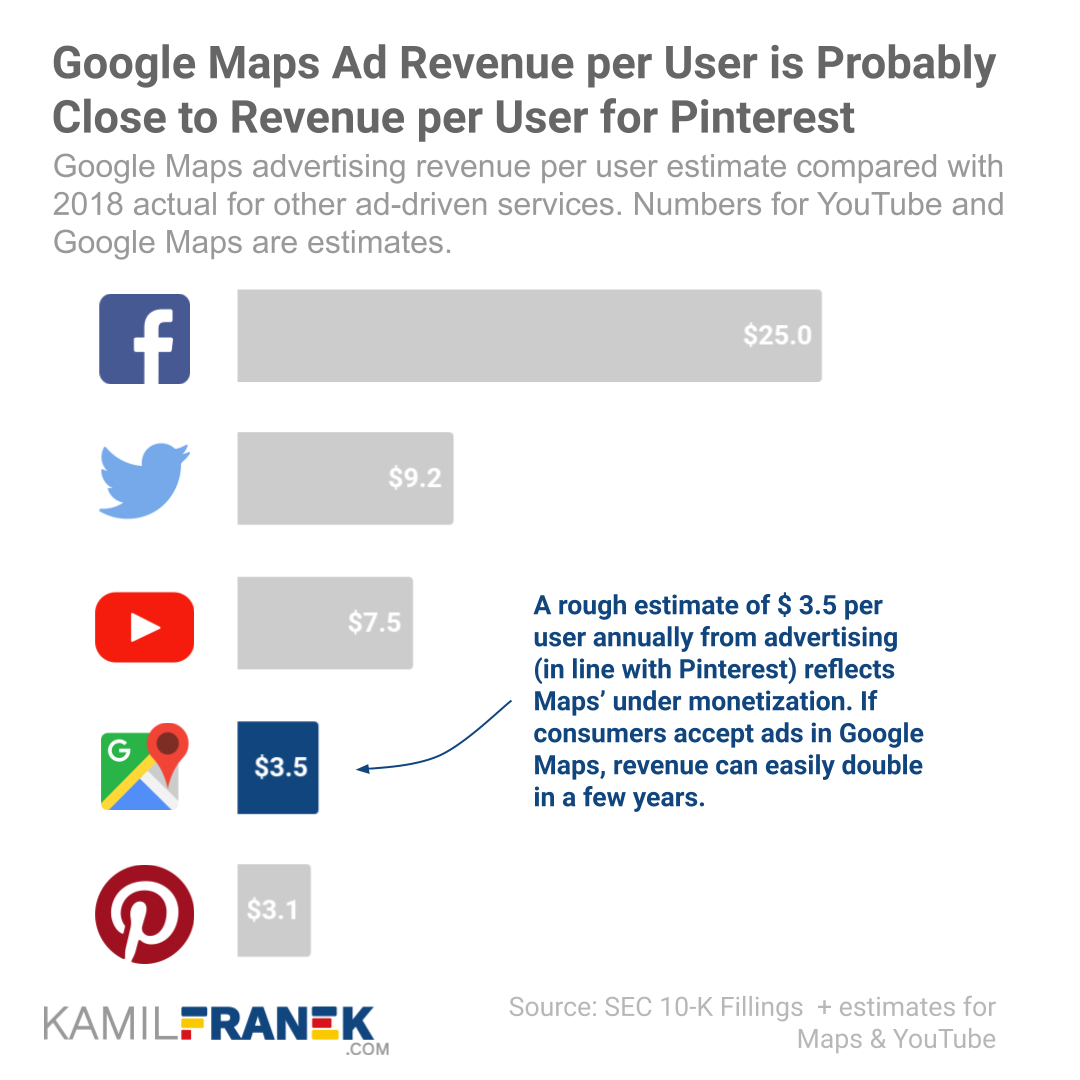
Here is a more detailed visualization where you can see both revenue per monthly active user from the previous chart on vertical axes but also on horizontal axis how many monthly active users particular service has. Bigger the icon, the larget is the total revenue of the business.
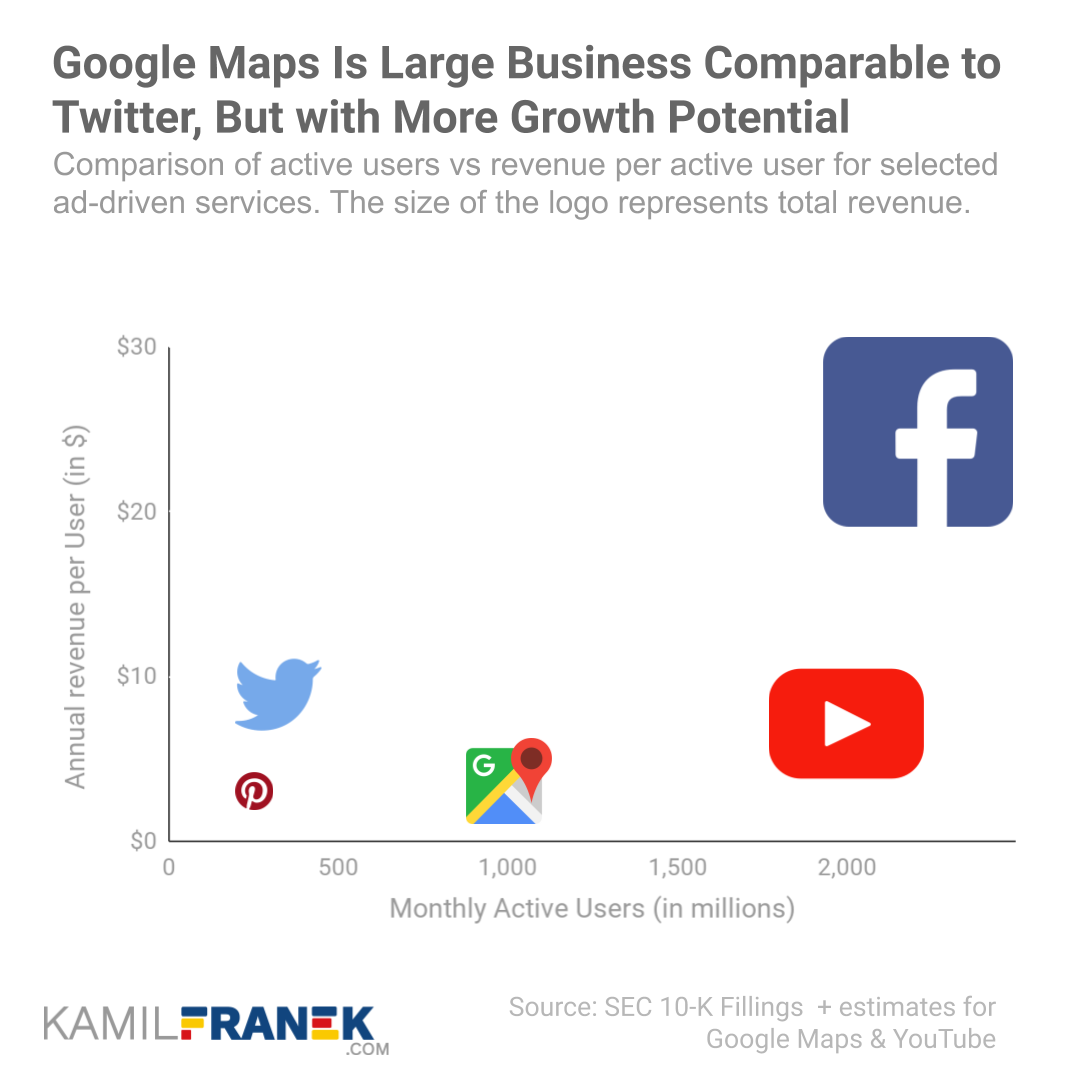
I included in the comparison also YouTube, but number for youtube reveneu are also estimate, because Google (Alphabet) does not diclose it financials. If you want to know more about YouTube current performance, revenue a how much it is probably worth check out my article about YouTube.
Step #3: How Benchmarks and Google Maps Differ
Now we have benchmarks that range from $25 for Facebook to $3.1 for Pinterest. This range is too extensive to make it usable for our estimate, but we have not finished yet anyway. We need to put together some facts about how Google Maps differs from the benchmark companies that can help ups to steer our estimate either to lower or higher benchmarks.
Differences between Google Maps and benchmarks (Social Apps) that I took into account are:
- monetization level of Google Maps is currently low, and that should be a reason to put our estimate closed to Pinterest because it is also lightly monetized
-
The time you spend on social media apps or sites is higher than the time you spend on Google Maps.
- Another fact to take into account is that Google Maps ads are served to users right at the moment where the user is looking for a restaurant or hotel and is ready to buy. Therefore Google Maps should get higher revenue per add shown to compare to social media apps
Step #4: Final Estimate
Now we are getting to the more subjective final stage of choosing the range for Google Maps revenue per user estimate. We will need to merge the data for our benchmark companies and the facts from the previous step and estimate the range within which Google Maps revenue per user will probably be.
My range of possible reasonable values is from $2 to $5 per active user, and here are my arguments: monetizations of Google Maps is at lower levels and will be close to what we see for Pinterest and not for more ad penetrated services like Twitter and Facebook. It might be even lower because screen time is significantly lower, and I guess that even bigger intent to buy will offset it.
Based on the reasons above, I chose my pessimistic scenario right below Pinterest and optimistic one below YouTube and Twitter levels from 2018.
My average estimate for revenue per active user of Google Maps is $3.5. If I multiply it by number for active users of Google Maps, I will arrive at a $3.5 bn revenue estimate for Google Maps. But as I mentioned, Google Maps do also have another income stream where they charge a fee for using Google Maps API by other businesses.
🔎 How Google Maps Earn Money from Its ⚙️ API and 🤝 Partnerships
Ads are, for sure, the most significant part of Google Maps revenue, but not the only one. Google is also offering Google Maps infrastructure to businesses and app developers. Google Maps API (or now called Google Maps Platform) offers to tap into infrastructure and data that Google uses to run Google Maps.
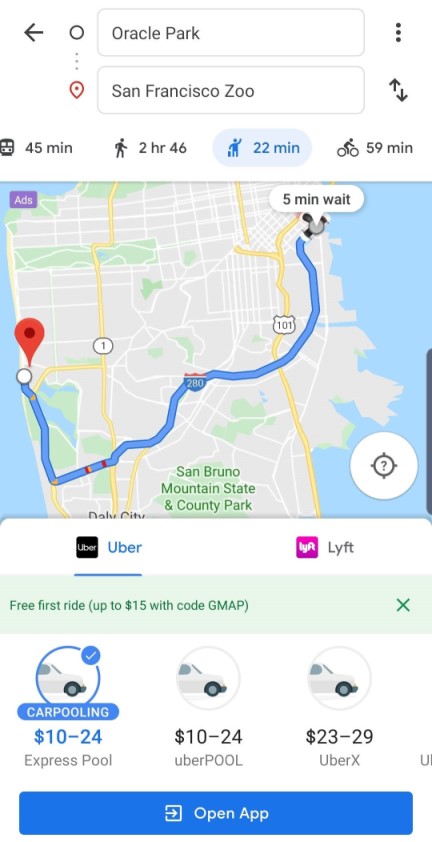
You can use custom Google Maps within your applications or web service, use Google Maps navigation & route planning, and also tap into the Google Maps data about all the places around the world and using withing your application.
Google made significant changes in 2018 to Google Maps API. They consolidated 18 different services into only 3 they now offer (Maps, Routes, Places) and also increased the pricing significantly.
The most prominent customers using Google Maps API are mobility apps Uber and Lyft. Uber and Lyft rely heavily on Google mapping technology a mentioned this also to their investors during their initial public offerings.
“We rely upon certain third parties to provide software for our products and offerings, including Google Maps for the mapping function that is critical to the functionality of our platform. We do not believe that an alternative mapping solution exists that can provide the global functionality that we require to offer our platform in all of the markets in which we operate.”
–from Uber’s IPO prospectus.
It is important to note that Alphabet, Google’s parent company, has a small equity share both in Lyft (4.4%) and Uber (4.2%). Both of these companies, together with other mobility service providers, have a deeper partnership with Google because their service is integrated directly in Google Maps. As you can see in the example below, You can see the availability of different taxi services in your location, and there are direct links to Lyft and Uber apps from within Google Maps.
Uber and Lyft are not the only partners (Uber was the first one since 2014). Other partners that are integrated in Google Maps are for example:
- 99Taxis (Brazil)
- Ola Cabs (India)
- Hailo (U.K+Spain)
- mytaxi (Germany+Spain)
- Gett (UK)
💵 How Much Money Google Maps Makes from Maps API and Partnerships
My midpoint estimate for Google API revenue is $0.8bn a year, ranging from $0.3bn to $1bn. So what is the background of this estimate, how I arrived at it?
Compared to the estimate of advertising revenue, there is far more uncertainty about it because I am not aware of some publicly available numbers that would help me to narrow it down. The only official number I am aware of is the one UBER disclosed in their IPO prospectus. According to the document, Uber paid between years 2016 and 2018 $58 million to Google for its Google Maps service.
UBER also discloses the number of rides each year, and since payment is most probably dependent on rides, we can deduce from that that in 2018, Uber paid around $28 million for Google Maps service in 2018. That was on top of a slightly higher amount for Google Cloud services that were disclosed separately.
That’s it, that’s all the data we have right now. Estimating based on this is guesswork with high uncertainty. If it were a more important part of Google Maps’ revenue, I would probably spend more time looking for some other data points directly from google or some benchmarks from somewhere else.
I know that Uber is one of the biggest customers for Google in Google Maps API but no the only one. My very conservative assumption would be that Uber is 10% of revenue, which means that in total, Google API would earn $ 0.3 billion. The higher end of my assumptions would probably be around $1 bn, assuming that there is more revenue coming in from bigger customers and also som income from a lot of smaller ones.
I do not expect that revenue above $1bn is too probable. Google says that the total revenue of Google Cloud is $8 billion a year, and Google Maps is probably not a major source of this revenue.
Therefore, my final estimate for Google Maps API revenue is $0.65 bn with a range from $0.3bn to $1bn.
⚖️ How Much Revenue Google Maps Earns Compared to Alphabet Inc. Revenue
Google Maps revenue, according to my estimate, is $4.3bn a year. It is impressive, but it is just a small drop in Google’s total revenue. The total revenue for Alphabet Inc (Google’s parent company) is $137bn in 2018. Google Maps are just 3% of total revenue.
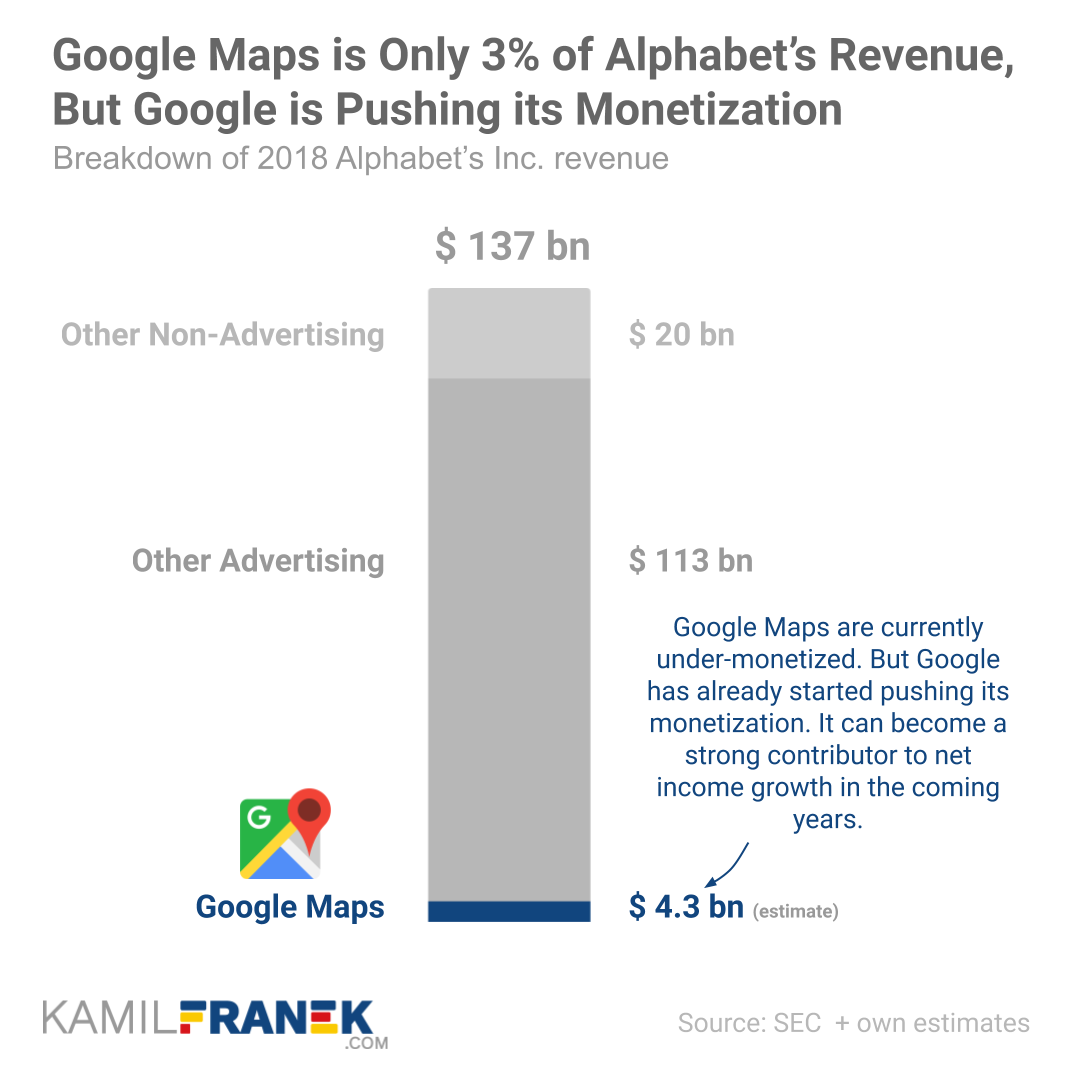
The reason why Google Maps is just a big opportunity is not that it is a large revenue generator right now. The main point is that this revenue has a significant potential to double to $9 billion or even more in a couple of years. That can help significantly in net income growth in the coming years.
If you want to explore Google Financials further a recommend my article reviewing their recent annual report.
💰 How Much Is Google Maps Worth: Valuation of Google Maps as a Standalone Business.
Google Maps is becoming a significant business. And even though it is small compared to Google, it would be a large Fortune 500 company if we would think of it as a standalone business.
Lets to just quick calculation of how much could Google Maps be worth standalone. We know (or at least have an estimate) Google Maps revenue, and therefore we can get a quick rough valuation by using revenue multiple.
That means looking at some similar companies, look at their relationships between company value and revenues, and use this as a multiple of Google Maps revenue to arrive at a rough valuation.
The most appropriate publicly traded company with a similar business model as Google Maps is, obviously, Alphabet Inc. Alphabet market capitalization was oscillation around $800bn in 2018, and when we compare it to 137bn revenue, the multiple is 5.8.
Now, to arrive at a reasonable valuation, it would be wrong to use $4.3bn of current revenue we estimated and multiply it by revenue multiple. We have to take into account an estimate of revenue it will Google Maps earn after the current monetization push will be evident in revenue.
My final rough Google Maps valuation is $50 bn calculated as 8.6bn (revenue potential in a few years) * 5.8 (revenue multiplier of Alphabet Inc).
❓ Is Google Maps Service Using Waze data? Are These Two Apps Connected?
As you know, Google acquired navigation app WAZE in 2013 that is currently still running as a separate service from Google Maps.
According to Google, Google Maps does not use any data from the Waze app they want to leave it that way. So these two apps are independent of each other.
It might look weird to someone, but it seems like one of the standard Google acquisition templates. First, buy the service or application, then copy everything usable into your apps, and finally, let it die by slow death.
We will see how long will Waze survive because Google Maps recently introduced a lot of “Waze” like features like community-driven data on crashes, speed traps, and traffic slowdowns.
📚 Resources & Links
- Who Really Owns Google (Alphabet) and Who Controls It
Overview of who owns Alphabet (Google) and who controls it. With a list of the largest shareholders and how much is each of their stake worth. - Google Maps Platform homepage, where you can find more details and use cases for Google Maps API and also their current pricing.
- Uber IPO Prospectus: Contains how big equity share Google has in Uber and also how much it paid for Google Maps service and how much Uber spend on Google Maps services.
- Lyft IPO Prospectus: Lyft mentions Google Maps as a critical service they rely on. The document also states how big share Alphabet Inc has in the company.
Disclaimer: Although I use third party trademarks and logos in this article and its visuals, kamilfranek.com is an independent site, and there is no relationship, sponsorship, or endorsement between this site and the owners of those trademarks.

